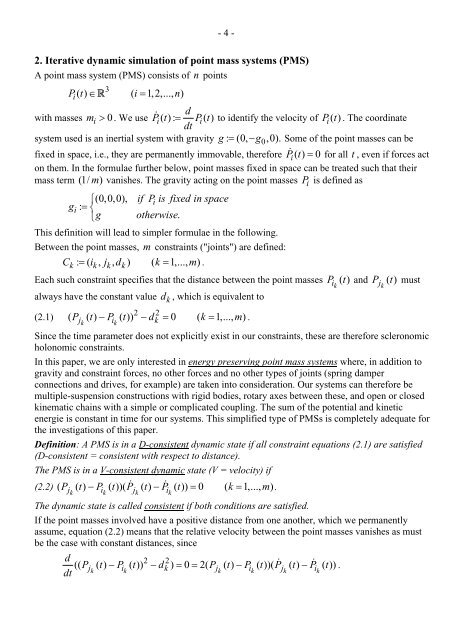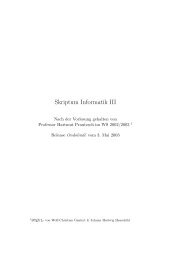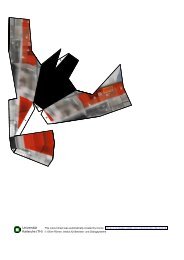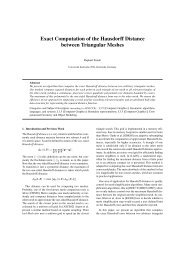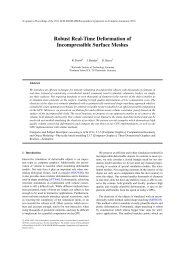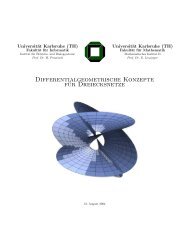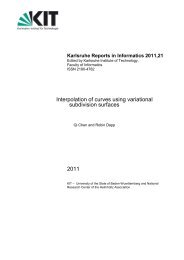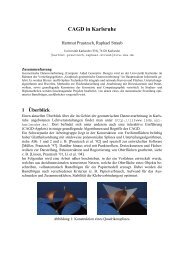On the Convergence and Correctness of Impulse-Based Dynamic ...
On the Convergence and Correctness of Impulse-Based Dynamic ...
On the Convergence and Correctness of Impulse-Based Dynamic ...
Create successful ePaper yourself
Turn your PDF publications into a flip-book with our unique Google optimized e-Paper software.
- 4 -<br />
2. Iterative dynamic simulation <strong>of</strong> point mass systems (PMS)<br />
A point mass system (PMS) consists <strong>of</strong> n points<br />
3<br />
Pt i()<br />
∈ R ( i= 1,2,..., n)<br />
d<br />
with masses m i > 0 . We use Pt &<br />
i(): = Pt i()<br />
to identify <strong>the</strong> velocity <strong>of</strong> Pt i()<br />
. The coordinate<br />
dt<br />
system used is an inertial system with gravity g: = (0, − g0,0).<br />
Some <strong>of</strong> <strong>the</strong> point masses can be<br />
fixed in space, i.e., <strong>the</strong>y are permanently immovable, <strong>the</strong>refore Pt &<br />
i()<br />
= 0for<br />
all t , even if forces act<br />
on <strong>the</strong>m. In <strong>the</strong> formulae fur<strong>the</strong>r below, point masses fixed in space can be treated such that <strong>the</strong>ir<br />
mass term (1/ m ) vanishes. The gravity acting on <strong>the</strong> point masses P i is defined as<br />
⎧(0,0,0),<br />
if Pi is fixed in space<br />
gi<br />
: = ⎨<br />
⎩g<br />
o<strong>the</strong>rwise.<br />
This definition will lead to simpler formulae in <strong>the</strong> following.<br />
Between <strong>the</strong> point masses, m constraints ("joints") are defined:<br />
Ck : = ( ik, jk, dk) ( k = 1,..., m)<br />
.<br />
Each such constraint specifies that <strong>the</strong> distance between <strong>the</strong> point masses Pi() t <strong>and</strong> P ()<br />
k j t must<br />
k<br />
always have <strong>the</strong> constant value d k , which is equivalent to<br />
(2.1)<br />
2 2<br />
jk ik k<br />
( P ( t) −P ( t)) − d = 0 ( k = 1,..., m)<br />
.<br />
Since <strong>the</strong> time parameter does not explicitly exist in our constraints, <strong>the</strong>se are <strong>the</strong>refore scleronomic<br />
holonomic constraints.<br />
In this paper, we are only interested in energy preserving point mass systems where, in addition to<br />
gravity <strong>and</strong> constraint forces, no o<strong>the</strong>r forces <strong>and</strong> no o<strong>the</strong>r types <strong>of</strong> joints (spring damper<br />
connections <strong>and</strong> drives, for example) are taken into consideration. Our systems can <strong>the</strong>refore be<br />
multiple-suspension constructions with rigid bodies, rotary axes between <strong>the</strong>se, <strong>and</strong> open or closed<br />
kinematic chains with a simple or complicated coupling. The sum <strong>of</strong> <strong>the</strong> potential <strong>and</strong> kinetic<br />
energie is constant in time for our systems. This simplified type <strong>of</strong> PMSs is completely adequate for<br />
<strong>the</strong> investigations <strong>of</strong> this paper.<br />
Definition: A PMS is in a D-consistent dynamic state if all constraint equations (2.1) are satisfied<br />
(D-consistent = consistent with respect to distance).<br />
The PMS is in a V-consistent dynamic state (V = velocity) if<br />
(2.2) ( P ( t) −P ( t))( P& ( t) − P& ( t)) = 0 ( k = 1,..., m)<br />
.<br />
jk ik jk ik<br />
The dynamic state is called consistent if both conditions are satisfied.<br />
If <strong>the</strong> point masses involved have a positive distance from one ano<strong>the</strong>r, which we permanently<br />
assume, equation (2.2) means that <strong>the</strong> relative velocity between <strong>the</strong> point masses vanishes as must<br />
be <strong>the</strong> case with constant distances, since<br />
d 2 2<br />
(( Pj () t −P ()) ) 0 2( () ())( () ())<br />
k i t − d<br />
k k = = Pj t −P k i t P& k j t −P&<br />
k i t .<br />
dt<br />
k


